Roberto Cecchini - INFN, Florence; Fulvia Costa
- INFN, Padua; Alberto D'Ambrosio - INFN, Turin; Domenico
Diacono - INFN, Bari; Giacomo Fazio - INAF, Palermo;
Antonio Forte - INFN, Rome; Matteo Genghini - IASF,
Bologna; Michele Michelotto - INFN, Padua; Ombretta
Pinazza - INFN, Bologna; Alfonso Sparano - University of
Salerno
Pp. 17-29 of the Proceedings of LISA '06:
20th Large Installation System Administration Conference
(Washington, DC:
USENIX Association, December 3-8, 2006).
Abstract
Sec-mail is a group of site administrators in the GARR (Gruppo
Armonizzazione Reti della Ricerca - Research Networks Harmonisation
Group) network dedicated to the security of E-mail services. GARR is
the National Research and Academic Network of Italy.
The main points covered are in: methodologies to improve the
efficiency of spam detection (mainly tuning of SpamAssassin),
definition of best practices in electronic mail administration, sender
domain authentication, greylisting and spam monitoring.
Introduction
The National Research and Academic Network of Italy, or GARR,
formed the working group SEC-MAIL to study IT security related
problems on its network. This group was formed following a proposal by
Roberto Cecchini at the V GARR Workshop held in Rome in November 2003.
The group examines the following technologies:
-
spam;
-
viruses and worms spread up by E-Mail;
-
best practices for mail-server configuration and security;
-
authentication of sender mail-server;
-
greylisting technologies;
-
graphs and statistics.
This paper presents a summary of the group's findings to date.
Since the fall of 2004, the group has its own web area and a wiki site
[WSM], where both the results of the experiments and the produced
documentation are made available.
Initially, the group focused its work mainly in SpamAssassin
tuning in order to improve the spam detection by Bayesian filters,
non-standard rules, and technologies based on mass-emailing
distributed identification. Some experimental DCC (Distributed
Checksum Clearinghouse) servers were set-up, and made available to the
GARR community on a best-effort basis. Then, greylisting has been
enabled on three pilot sites, and with an experimental technology in
one of them. A huge amount of graphs and statistics has been produced
which have surely helped the several experimental activities of our
working group.
We will discuss our efforts to prevent spam and then discuss
viruses and worms. This is followed by best practices, Sender domain
authentication, greylisting technologies, and a conclusion.
Controlling Spam
Spam: A Security Problem
In the past years the number of unsolicited E-Mail messages coming
in the mailboxes of users has grown from a nuisance to a real problem.
Some sites report that less than 10 percent of their messages are
good. Of course the problem has been transferred to the site
administrator who has the control of the mail-server. The most expert
user can cope with a self-made filter (procmail) and
with the filter embedded in the Mail User Agent application (such as
Outlook and Thunderbird).
The problem is not only in terms of time lost by users deleting
spam messages, but also the resources needed in the mail-server, and
the relation with security problems like viruses and worms used to
send spam, scam, phishing and brute force address harvesting.
This is the background that led to the birth of a group of large
site (thousand of mailboxes each) administrators in the GARR network.
The group goals include the study of all security problems related to
electronic mail with a clear urgency to deal with the spam explosion.
The Common Base: SpamAssassin
The group activity concentrated itself in understanding how it
would be possible to improve the SpamAssassin (SA) efficiency by
reducing negatives and (mainly) false positives.
SpamAssassin is based on heuristic tests using genetic algorithms,
and automatic Bayesian statistical corrections. So, the spam nature of
every single E-Mail message is determined in a statistical way. Thus,
independently of how well tuned the configuration parameters might be,
there will always be some positives (good messages erroneously tagged
as spam) as well as some negatives (spam messages undetected).
When a message's ``SpamAssassin score'' is higher than a specific
value, the message will be considered spam, and the administrator can
decide its destiny: remove it, move it to a specific folder or, most
commonly, just flag the E-Mail as probable spam by modifying the
subject in order to leave its destiny in the users' hands.
A trivial method used to increase the number of messages detected
as spam is either to decrease the spam score level, or increase the
score value of some tests. This must be done carefully because, in the
first case one will increase the probability of positives, while in
the second case one will unbalance the score value between the
hundreds of tests.
For these reasons, we decided to study independent methods to
improve the filter efficiency, that is, increase the spam/ham
distribution separation.
The Bayesian Classifier
The use of Bayesian filters is very effective. With this method,
the filter learns the right rule from lists of ``certain'' spam and
ham messages which have been classified by a human. The filter
produces two tables of the most frequent words (actually tokens, since
the message header is also analyzed) found both in spam and ham
messages. After this learning phase, every incoming message is given a
score, whose value is assigned depending on the spam/ham token
frequency. This method is quite independent from the rule-driven one,
because it also works on good messages and is customized for each
mail-server target.
However, this method must be used carefully. The training of the
bayesian classifier is a critical step. The efficacy of the bayesian
filter is influenced by the spam/ham database size. It must be big
enough to contain all relevant tokens, but not so big as to contain
old (no longer relevant) tokens. Tests made in the Turin site gave the
best results by lowering the parameter bayes_expiry_max_db_size from
200 to 100.
The auto-learning option can be exploited by spammers who send E-Mail
messages designed to poison the DB with a huge amount of random
``non spam'' words. In this way, the Bayesian filter might even auto-poison
its own DB.
The countermeasure is the DB correction, made by users' feedback.
Every day, each user can re-classify all received positives and alse
negatives. Tests made in the Turin site have shown that the ``right''
DB strongly helps in this reclassification of spam/ham messages. For
example, in Turin the best results have been achieved with a central
DB, so that the spam is targeted on a whole site basis instead of a
per-user basis.
The training of the Bayesian filter on the users feedback gave
excellent results. As shown in Figure 1, the Bayesian solid test line
for the BAYES_99 (99% probability of being a spam) is very close to
the total spam detected line.
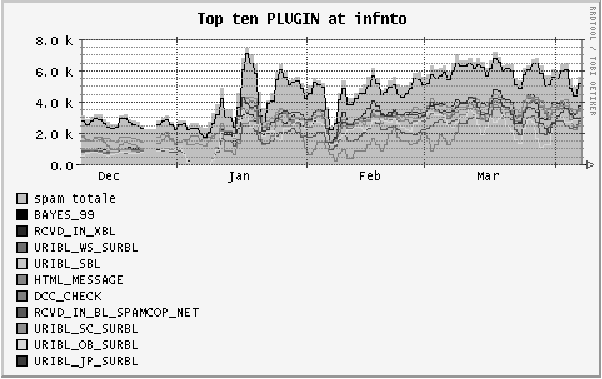
Figure 1: Usual trend for top ten SpamAssassin plug-ins
at INFN-TO (Dec 2005-Apr 2006).
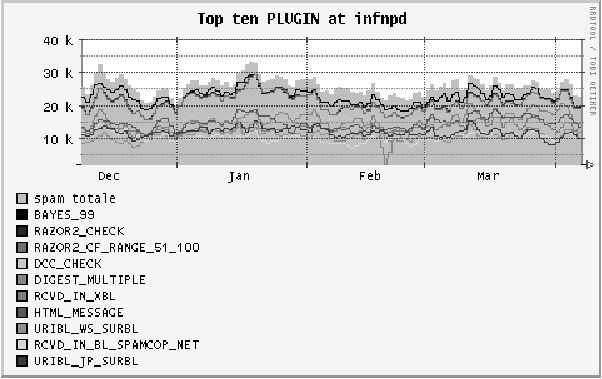
Figure 2: Usual trend for top ten SpamAssassin plug-ins
at INFN-PD (Dec 2005-Apr 2006).
At the Padua site the above reclassification is made by the site
administrator by manually feeding the DB with selected ham & spam. In
this case the two lines are a little bit more separated (see Figure
2). Results are even worse at other sites that still haven't applied
any kind of statistical correction.
We've set up a monitoring system for the efficiency of the several
tests used by SpamAssassin (see Figure 3 and Table 1, referred to one
site only). Table 1 represents, for each plug-in:
-
score: the single plug-in score assigned by
SpamAssassin;
-
score %: plug-in score percentage compared with the
required score;
-
hit: the number of E-Mail messages tagged as spam;
-
hit %: percentage of E-Mail messages tagged as spam by
the plug-in;
| Plug-in name | Score | Score % | Hit | Hit %
|
| BAYES_99 | 4.070 | 116% | 5640 | 94.0%
|
| RCVD_IN_XBL | 3.897 | 111% | 4163 | 69.4%
|
| URIBL_WS_SURBL | 2.140 | 61% | 3725 | 62.1%
|
| URIBL_SBL | 1.639 | 46% | 3534 | 58.9%
|
| HTML_MESSAGE | 0.001 | 0% | 3244 | 54.1%
|
| DCC_CHECK | 3.500 | 100% | 3047 | 50.8%
|
| RCVD_IN_BL_SPAMCOP_NET | 3.500 | 100% | 3040 | 50.7%
|
| URIBL_SC_SURBL | 4.498 | 128% | 3035 | 50.6%
|
| URIBL_OB_SURBL | 3.008 | 85% | 3023 | 50.4%
|
| URIBL_JP_SURBL | 4.087 | 116% | 2929 | 48.8%
|
Table 1: Numeric values at INFN-TO
referred to the 2006-04-07 log.
Switching SpamAssassin from release 2 to release 3 dramatically
improved the spam detection ability of the filter, especially with
releases 3.1.x. The Bologna site experienced a false negative
reduction from 20% to 1%, and a false positive reduction from 0.8% to
0.2%.
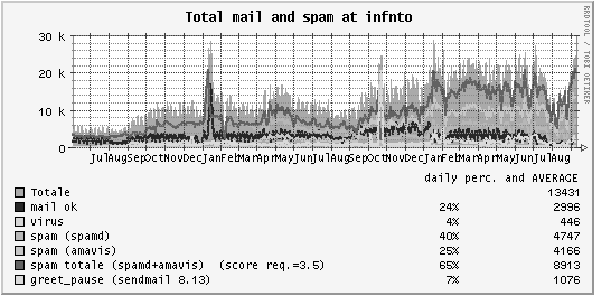
Figure 3: Number of E-Mail messages received at INFN-TO
from June 2004 to September 2006.
Non-Standard Rules
In addition to the standard rules, SpamAssassin can use non-standard
plug-ins to further improve its spam detection ability. The
Florence site experimented with both the URIBL and SARE families of
plug-ins (see Figure 4).
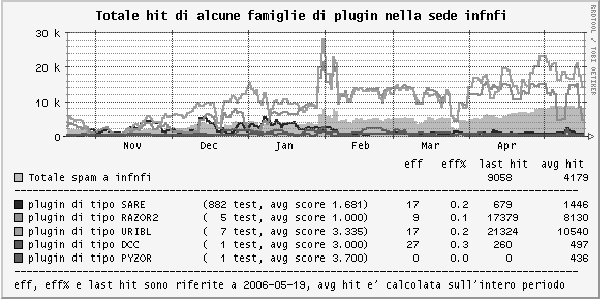
Figure 4: Usual trend for some SpamAssassin plug-in
families at INFN-FI (Oct 2005-May 2006).
The URIBL family (a sort of distributed black-list, included by
default in the SpamAssassin package, starting rel. 3) is based on the
harvest of sites linked from URL's internal to spam messages. Because
in most cases, while message headers don't indicate where spam
actually comes from, the message body must contain links useful for
the spammers. We have found it very useful, especially with
SpamAssassin rel.2, where it wasn't included by default.
The SARE family (still not standard) gathers different
countermeasures against brand-new spamming techniques. For example, we
found the gibberish plug-in (against random words
inside the body of some spam messages) to be very useful.
Among non-standard plug-ins we also considered mail-scanners,
which are high-performance and reliable interfaces between mail
transport agents (MTA) and one or more content checkers. They perform
a light anti-spam scan before the final call at SpamAssassin.
Using Mail-Scanners
Special behaviors may be obtained by using the aforementioned
mail-scanners. Since the beginning of the group effort, the Turin site
has been using the AMaViS [AMA] mail-scanner for both anti-virus and
anti-spam filters. The Florence site, instead, developed its own mail-scanner
(RJSPAM) [RJS]. However, both sites use these mail-scanners to
reject spam depending on the results of SpamAssassin tests: in Turin
for those users that explicitly asked for this behavior (opt-in),
while in Florence for those users that still haven't
explicitly refused it (opt-out).
When one receives hundreds of spam messages per day, hijacking
them into special folders is completely useless: one will never check
them! So, rejecting them might be a wise solution because a spam
message is a sender mail-server object, not of the receiver server!
Another positive effect is in terms of performance. With mail-scanners,
the scanning takes about a tenth of the time of the usual
anti-virus and anti-spam software, since it interacts directly with
the libraries, without calling any (slow) executables.
Finally, we suspect there is a useful side-effect: rejecting spam
will cause one's (spammed) address to be removed from the spammers'
mailing lists! But this behavior has yet to be confirmed (we need
further collecting time).
However, the working group members didn't come to a common
agreement on the policy of rejecting such messages. Some members think
it is unethical, even though it respects all RFC's. Others, instead,
simply don't like it.
RBL
Another independent tagging system is the one based on the
RealTime Block List [RBL]. The sender E-Mail address is compared with
a notorious spammers' database by a DNS query. These databases are
maintained by user communities that collect the names of Internet
Service Providers housing spammers, allowing open-relays, badly
configured proxies or message sending from dynamic addresses. However,
blocking lists must be used carefully as they are sometimes too slow
in removing good sites, or not very accurate in checking that the
reported site was actually guilty. For this reason, RBL scores are
better used in conjunction with other rules, and not by themselves.
As stated above, among the several RBL's we have tested, there was
a specific one we have found really useful: the URIBL family.
Automatic Categorizers (Community Based & Checksumming)
These systems are based on distributed servers that ``count'' the
received messages in order to compute the probability they may be of
type Unsolicited Bulk E-Mail (UBE).
Razor
Razor [RAZ] is based on a database of spam E-Mail messages
supplied by humans. A sophisticated scoring mechanism based on correct
reports or revocations of spam makes this reporting mechanism
unalterable by spammers. Since Razor was based on a private protocol,
it wasn't easy to enter into the razor collaborative network. However,
RAZOR is partially free.
Pyzor
Pyzor [PYZ] is an open-source rewriting of Razor. Our group is
trying to enter its more open collaborative network.
DCC
This product [DCC] is based on a slightly different mechanism. DCC
servers automatically ``count'' bulk E-Mail messages by trying to cut
away the variable elements and keeping the fixed ones, generating a
checksum for each of them. After that, DCC servers exchange this
information with a flooding mechanism. In this way, for every incoming
message, a mail-server can ask a DCC server for the probability that
this message, with such a checksum, has to actually be UBE. Any DCC
server gives answers to both client types, anonymous and registered.
Higher priority is usually given to the latter ones.
DCC is an open system where new servers are always welcome. All
working group member sites have been using DCC clients since the group
was founded, while four sites are even hosting servers. The first
Italian DCC server was installed at INAF in Palermo, immediately
followed by the INFN site of Turin [DCT]; then Rome and Bari. At
first, we thought three servers would be enough, but new GARR site
volunteer servers have always been welcome in order to better serve
the increasing number of GARR clients. Our achievement is an
improvement of the method efficiency, both by reducing the response
time and by increasing DB data about our domestic spam. Even
though the service is offered on a best effort basis only, the Turin
server has been recently replaced with a more powerful one; due to
this refurbishment, it has been included in the default DCC server
alias (dcc*.dcc-servers.net) and is currently serving thousands
of clients worldwide, checking an average of 15 M messages/day (12.5%
of the total, see Figure 5).

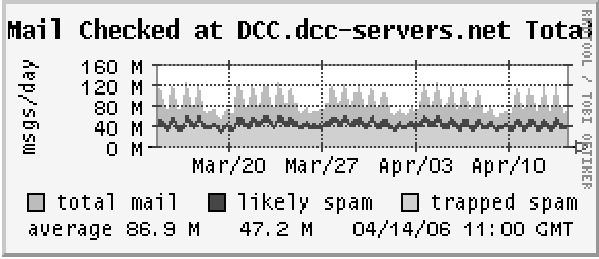
Figure
5: E-Mail checked at dcc.to.infn.it, compared with the total at
dcc.dcc-servers.net.
After using this new DCC server, the Turin mail-server
unexpectedly started increasing its spam detection efficiency, with
false positives and false negatives nearly equal to zero. We are
investigating this coincidence, but we suspect that the different new
role of the Turin DCC server affected its spam detection ability (see
Figure 6). In fact, because of its inclusion in the default DCC server
alias, its database now contains data which is more up to date than
when it was interacting with fewer clients (the domestic ones
only) and processing fewer messages, and the DB was aware of the rest
of the world by a data flooding between DCC servers only.
DCC Reputations are a distinct mechanism based on and contributing
to DCC data. In part to minimize abuse by anonymous users, DCC
Reputations are available only in the commercial version of the DCC
software. For this reason, our working group still hasn't considered
implementing it, but we cannot exclude begging it from Vernon in the
future . . .

Figure 6: Spam ratio at dcc.to.infn.it from May 2005 to
April 2006.
DSpam
DSpam [DSP] is a spam detection system proposed as an alternative
to SpamAssassin. It's based on highly sophisticated statistical
techniques only. Even though the authors achieve an efficiency better
than 99.9%, not only did our testing not reach this value, but showed
results worse than SpamAssassin. Perhaps our training phase quality
(not accustomed to purely statistical methods) was not as good as
required. For the future, we are currently considering its possible
implementation as a plug-in of SpamAssassin.
Viruses and Worms
Fortunately, nowadays anti-virus filters for mail-servers are
quite robust and reliable. Free software surely has good examples of
well designed products (i.e., ClamAV), but commercial software is
usually better due to faster virus definition updates (i.e., Sophos
AV). Nevertheless, commercial software doesn't always imply more
reliability.
For the whole working group the number of viruses revealed
by E-Mail decreased very quickly by simply adopting good anti-virus
filters, implementing greylisting, and following some best practices
(discussed in the next section).
As shown by the green line in Figure 7, in less than one year, the
total amount of viruses revealed in some GARR sites decreased
from 30% to nearly zero.
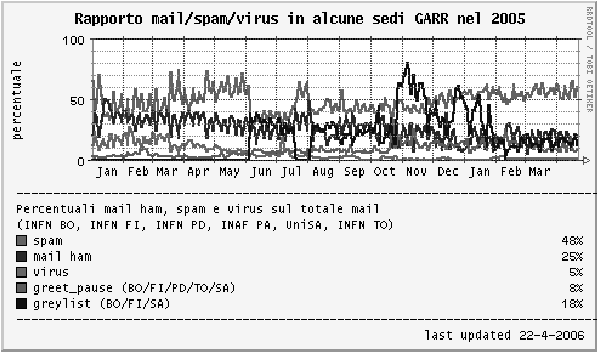
Figure 7: Ham, Spam & Virus on total E-Mail, in some
GARR sites from Jan 2005 to Apr 2006.
Best Practices
An important part of the working group activity has been dedicated
to ``best practices,'' that is suggestions to improve the
security of E-Mail services.
Among the most important points identified:
-
Edge routers should allow incoming traffic through port 25 (smtp) to
reach only the domain official mail-server, in order to prevent
generic LAN computers from being used as mail-relay.
-
Edge routers should pass only outbound traffic through port 25 (smtp)
from the domain official mail-server, in order to prevent viruses and
worms from sending E-Mail messages (at present, a typical behavior).
Ports 587 (msa - mail message submission), and possibly 465 (formerly
for Windows Outlook mail message submission, currently deprecated),
must be left open, so roaming users can use their
own MTA from the exterior of the LAN.
-
Roaming users must be able to use their own MTA from the exterior of
the LAN by authentication only. This way one can implement sender
control methods (i.e., SPF). Be careful when using authentication
together with SpamAssassin! If a user's Internet Service Provider
(ISP) has a bad reputation, SpamAssassin may consider his messages to
be spam. In order to prevent this, the following rule should be added
when using Sendmail as MTA:
header LOCAL_CERT_GNORRI_ON Received =~
/\HEADERSTRING\].+verify=OK\)/
score LOCAL_CERT_GNORRI_ON -15
where HEADERSTRING is typical of one's mail-server header. ISP's with
bad reputation are a very annoying problem. Unfortunately, in Italy
it's a common issue, mainly with cheaper and faster ISP's. So, due to
the latter ones, non guilty users risk being classified as spammers
even when using web-mail interfaces, if they list the ISP in the
message header because of some RFC (821) interpretation.
-
The anti-virus software installed on the mail-server should be
configured to prevent itself from sending information messages (about
infected E-Mail messages) to the senders, since these ones are usually
spoofed (false).
-
The Sendmail (v. 8.13) Greet Pause feature should be kept active.
Through this mechanism, the SMTP connection is rejected if the sender
mail-server doesn't wait for the ``220'' greeting answer. This is the
typical behavior of spammer software and viruses, which are usually
not able either to hold-on or, after a time-out, to retry the
connection as regular MTA's do.
For (not only) GARR users, an Installation manual for an
electronic mail service with anti-virus and anti-spam filters
[MAN] has been published (presently available in Italian only).
Sender Domain Authentication
Another important argument is the sender server authentication,
because partially related to the spam problem (many spam messages come
with the sender spoofed). Moreover, roaming users must be able to use
their own MTA from the exterior of the LAN by authentication only.
Several methodologies have been proposed, even though not yet
merged into a RFC. Among the several proposals, two different
technologies have emerged. The first one is known as Sender Policy
Framework [SPF], the second as Sender-ID [SID], and both aren't
directly used for fighting spam, but only for authenticating the mail-server that is sending an E-Mail message. The basic concept of these
systems is that the user of a generic domain can send messages only by
those mail-servers explicitly authorized by their own domain. This
mechanism prevents E-Mail messages with a spoofed sender address from
being sent, but mainly prevents infected computers from sending spam
or viruses.
Our working group chose to test SPF, verifying all possible
benefits. A site can become SPF compliant by publishing the mail-server names authorized to send E-Mail messages with this site sender
addresses. The best achievements would be reached whenever the
majority of the sites publish the list of the authorized servers as
well as enter them into their own DNS records. However, we still are
far from this status. However, since some big ISP's already publish
SPF records, it's possible to use this information in order to modify
the SpamAssassin scoring. It shouldn't be forgotten that ISP's
implementing SPF must inform their roaming users that they cannot sign
their outgoing E-Mail messages with their own domain name when using
external IP addresses, because the SPF check would fail. Thus,
before publishing one's SPF record, one's users should be aware they
can send E-Mail messages by using authorized mail-servers only. For
this reason, relaying must be allowed but only by using specific
authorization mechanisms (i.e., either via password or X.509
Certificate).
Our tests, made on an actual domain (University of Salerno),
showed that 12% of messages received in one month (650K) came from
senders whose mail-servers were already SPF compliant. To this value
may be added another 20% of messages belonging to the examined domain,
reaching therefore a considerable 32% of E-Mail messages carrying SPF
information.
Starting June 2006, we decided to enable SPF on all mail-servers
managed from our working group members. At present, only in a
soft way, just to test it by the related SpamAssassin rules.
Greylisting Technologies
Nowadays over 60% of spam and viruses come from infected computers
(hijacked computers) and not from real servers. Machines infected by
these viruses try to emulate the behavior of a full-fledged mail-server, but this imitation fails to implement some functionalities.
This lack of functionality can be used to differentiate a real mail-server
from an infected machine.
The functionality used to differentiate between real servers and
infected machines is the retransmission capability, that is the
capability of a real server to retransmit a message if a receiver
server couldn't (or wouldn't) receive E-Mail from another server
(e.g., the receiver server is overloaded, or the receiver server uses
Greylisting).
The Greylisting [GRE] method is very simple. It examines only
three pieces of information (which we will henceforth refer to as a
``triplet'') in any particular E-Mail message delivery attempt:
-
The IP address of the host attempting the delivery
-
The envelope sender address
-
The envelope recipient address
From these, we now have a unique triplet for identifying an E-Mail
``relationship.'' With this data, we simply follow a basic rule,
which is:
-
If we have never seen this triplet before, then refuse this delivery
and any others that may come within a certain period of time with a
temporary failure.
Since SMTP is considered an unreliable transport, the possibility
of temporary failures is built into the core spec (see RFC 2821). As
such, any well behaved message transfer agent (MTA) should attempt
retries if given an appropriate temporary failure code for a delivery
attempt.
The main two limits of this approach are:
-
the delay time due to the temporary failure (from 30 minutes to some
days);
-
some ISP, like hotmail, use an entire subnet for SMTP
retransmission and not a single IP thus implying more difficulty to
identify the triplet.
Although the first one of these problems could be the less
important (since SMTP protocol does not guarantee the delivery time
for an E-Mail message), it becomes very annoying to the community of
users when the E-Mail Service is used more and more like an Instant
Message application rather than a postal service.
The second problem can be easily solved using the full sub range
(``C'' class Network) of an ISP as the IP address. This way every
server in the network that will retry to forward the E-Mail message
previously interrupted will be recognized as being the same server.
There is also a second approach to the subnet problem: SPF.
Domains like Hotmail and AOL, which are frequently faked and abused by
spammers, have introduced an SPF record into their own DNS domains.
That record can be used to improve the behavior of greylisting. If a
receiving server is with greylisting enabled and receives an E-Mail
message from Hotmail or AOL, it could look up the SPF record of the
sender domain and compare the sender IP with the ones allowed for the
sender domain. If the sender address is allowed then the greylisting
should accept that message as it is a real message. Spam and viruses
which are sent from hijacked computers don't come from the authorized
servers but rather from the infected computer itself.
The Advantages
Sharp Reduction of Received Viruses and Spam
Greylisting reduces the number of accepted E-Mail messages
processed by the receiver server and this greatly reduces the amount
of spam and virus to check. The price is a rise of the average
delivery time and an increase in E-Mail traffic (due to the
retransmissions).
In Figure 8 one can notice that the traffic shape changed
enormously in the month of June 2005, in concurrence with activation
of Greylisting filter at INFN-FI. The above picture represents:
-
Red line: messages identified as spam by SpamAssassin (with a score
threshold of 3.5);
-
Cyan line: messages rejected by greet pause of Sendmail 13.x;
-
Black line: messages rejected by (classic) Greylisting;
-
Yellow line: messages containing viruses;
-
Blue line: ``clean'' messages;
-
The last, the grey contour, is the sum of all the contributions.
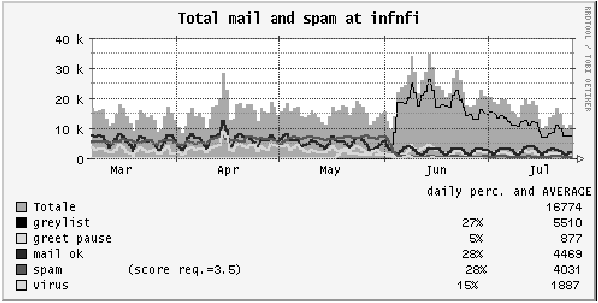
Figure 8: Number of E-Mail messages received at INFN-FI
from March to July 2005.
Two important aspects to underline are the trends of the blue and
grey lines: the first shows that real E-Mail preserves the same
behavior, the second represents the total number of messages processed
by the servers. The jump from 15K messages to over 30K daily is due to
retransmissions.
Sensitive Reduction of the CPU Load
Some measurements taken at University of Salerno, prove that only
20% of the incoming E-Mail is actually re-forwarded. About 80% of E-Mail
is immediately blocked by the Greylist algorithm. Considering
moreover that Greylist's algorithm is activated only during the first
step of the E-Mail protocol (header transmission), it means that 80%
the incoming E-Mail is zero-cost rejected as can be seen from Figures
9 & 10.

Figure 9: CPU load of a mail-server with classic
greylisting at UNISA.

Figure 10: CPU load of a mail-server without any
greylisting at UNISA.
In the first graph (Figure 9) we exhibit the CPU load of a mail-server
(mx3.unisa.it) equipped with greylisting technology while into
the second graph (Figure 10) we are reporting the CPU load of another
server (mx2.unisa.it) without greylisting functionalities. As can be
seen the load in the first graph is only a small portion of the CPU
utilized in the second situation.
The Disadvantages
The Delivery Time of the First E-Mail Message
The request for comment 2821 [RFC 2821], paragraph 4.5.4.1 Sending
Strategy, asserts that a sender must resend a rejected E-Mail message
after at least 30 minutes:
| |
``The sender MUST delay retrying to particular destination after one
attempt has failed. In general, the retry interval SHOULD be at least
30 minutes; however, more sophisticated and variable strategies will
be beneficial when the SMTP client can determine the reason for non-delivery.''
| |
Moreover it would have subsequently executed two connection
attempts in the first hour and one every two or three hours
thereafter:
| |
``Experience suggests that failures are typically transient (the
target system or its connection has crashed), favoring a policy of two
connection attempts in the first hour the message is in the queue, and
then backing off to one every two or three hours.''
| |
Other measures (Figure 11) performed on our servers at the
University of Salerno, show that approximately 30% of E-Mail is resent
within approximately 10 minutes, 60-70% of incoming E-Mail is instead
delivered after 30 minutes and finally, 80-90% of E-Mail is delivered
within 60 minutes from the first attempt.
There is also another disadvantage that can be felt as
particularly annoying: websites that require you to create an account
and confirm your E-Mail address before you can begin using them. Due
to the fact that greylisting will delay the initial E-Mail message
containing your signup confirmation link (maybe for some minutes or
perhaps some hours), it will introduce a waiting period even though
the actual website may send out your E-Mail confirmation code
immediately.
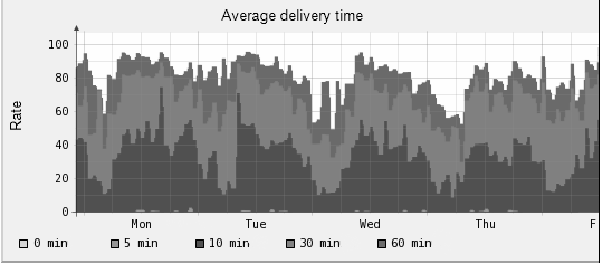
Figure 11: Average delivery time with classic
greylisting at UNISA.
A Better Greylisting
A Home-made Experimental Technology
The new approach to Greylisting is the union of classic
Greylisting with a spam filter. While Greylisting tells us if a
server is RFC compliant, spam filter tells us at which level of
confidence a message can be considered ham or spam. Joining the
two algorithms allows some optimization like bypassing the Greylisting
algorithm if the E-Mail message has a very low score or, in the case
of multiple recipients, accept an E-Mail message if only a single
well-know triplet that ``introduce'' the sender for all the others
exists.
These optimizations aim to reduce the delivery time for the first
E-Mail message.
The Achieved Result
As can be seen from Figure 12, more than 40% of E-Mail messages
are delivered instantaneously. Approximately 80% of them are instead
delivered within 30 minutes and 90%, with peaks of 100%, within 60
minutes. Essentially, from a direct comparison with the previous
diagram, one can notice a sharp improvement on the accepted times.

Figure 12: Average delivery time with experimental
greylisting at UNISA.
As shown in Figure 13, in one hour the mail-servers of
Universit&224; degli Studi di Salerno received 1197 E-Mail messages.
Only 12% of them are accepted as ham, while 3% are instead classified
as SPAM and 0.8% of E-mail is infected. The remaining part, 84%, is
rejected. Practically, 16.5% is rejected thanks to Greeting Pause, 21%
is rejected due to non-existent recipients and 45% is rejected by
greylisting where only 9.8% of these messages are retransmitted and,
therefore, accepted.
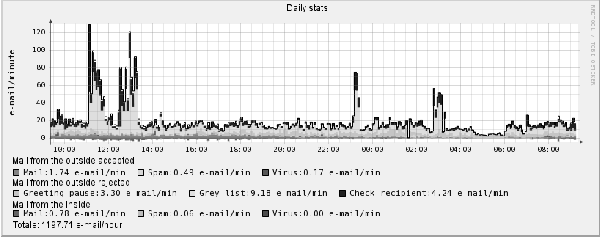
Figure 13: Daily E-Mail stats at UNISA.
The Cost
The consequence of this result is a sensible growth in the load on
the server and in the used network band. This is due to the fact that
all the E-Mail messages are, at least once, processed from the anti-spam
& anti-virus filter (see Figure 14).
In Figure 14, classic greylisting has been tested from October
2005 until January 2006, while experimental greylisting has been
running since February 2006.
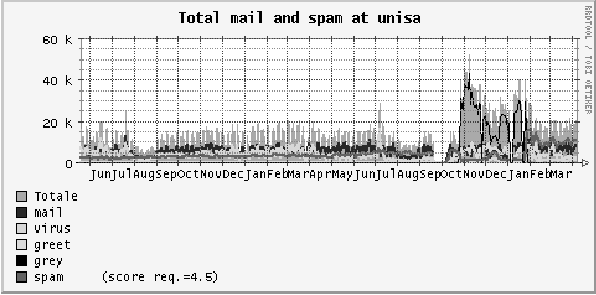
Figure 14: Number of E-Mail messages received at UNISA
from May 2004 to April 2006.
Conclusions (The Lesson Learned . . .)
A huge amount of graphs and statistics have been produced and are
available in (almost) real-time on the working group web site and wiki
[WSM]. They significantly helped us in highlighting many of the
achieved results, or just to quickly understand why the devil that
stupid mail-server stopped working . . .
Note that all the produced software is freely downloadable from
the sites listed either in the above paragraphs, or in the
``Bibliography'' section. This is the real-life story of 10 guys that
started ``playing'' within a new working group, and finished working
seriously, giving valuable results to the Italian Academic (and non)
network. From Figures 15 & 16 we see that, in spite of a more or less
constant increase of spam messages, we still have our mailboxes clean
thanks to a constant fighting activity of the whole working group.
Unfortunately, new/original tools are not always useful to get good
results and with our work we have demonstrated that one can achieve
excellent results even by using just standard tools. We've seen that
the more SpamAssassin plug-ins one uses, the more efficiency one will
obtain.
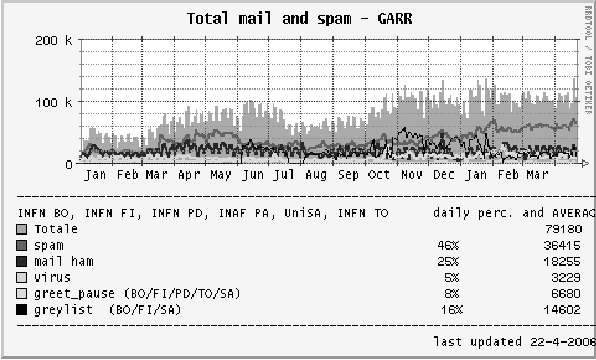
Figure
15: Number of E-Mail messages received at some GARR sites from Jan 2005 to
Apr 2006.
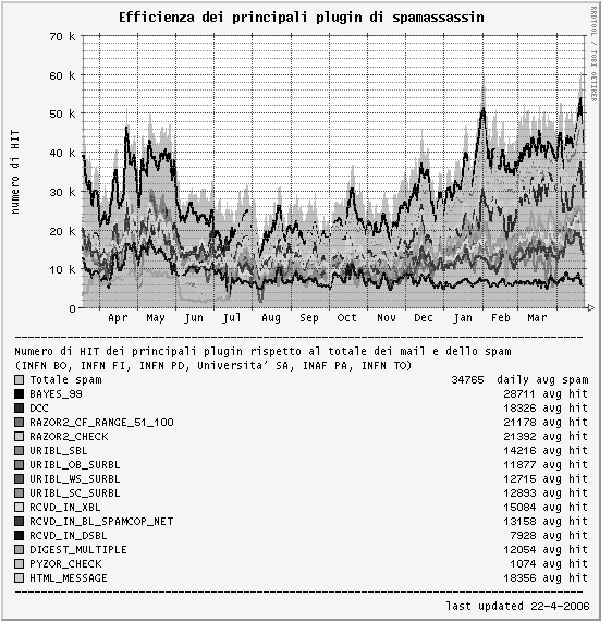
Figure
16: SpamAssassin plug-ins at some GARR sites from March 2005 to April
2006.
The statistical (Bayesian) approach resulted very effective (>
90% hits), and spammers seem still unable to go around it.
Provided you consider it ethical, rejecting spam let's the users
save time in checking the specific folders where spam messages are
hijacked.
Our very recent Italian DCC Servers Network has surely improved
the spam detection efficacy of the Italian (and non) clients installed
on mail-servers.
We found that greylisting provided a significant reduction in the
amount of spam received and processed and that greylisting combined
with SPF checking provided the greatest benefit.
Last, but not least, without a minimum of best practices, the best
anti-spam packages might result completely useless.
Thus, without this constant battle, is the war lost? Will I ever
be able to run a software that lets me forget my mail-server?
Author Biographies
Roberto Cecchini: Degree in Physics; Computing Centre Coordinator
at INFN in Florence; since 1999 GARR IT security service (GARR-CERT)
Coordinator; since 1998 INFN Certification Authority (INFN-CA)
Coordinator.
Fulvia Costa: LAN Manager & APM at INFN in Padua.
Alberto D'Ambrosio: Electronic Technician; Computing Centre System
Administrator at INFN (from 2000 at Turin Section, from 1992 to 2000
at Gran Sasso National Laboratories); previously analyst/programmer in
the area of industrial automation .
Domenico Diacono: Computing Centre System Administrator at INFN in
Bari.
Giacomo Fazio: IT Engineer; System and Network Administrator at
INAF/CNR in Palermo: E-Mail system manager, Computing Centre
Coordinator (from 1991 at IFCAI, then IASF, now INAF); previously
programmer for research groups working in the area of astrophysics.
Antonio Forte: IT Technician; Computing Centre System
Administrator at INFN in Rome1 (from 1/1/2004), Turin (1998-2003) &
Rome2 (1996-1998).
Matteo Genghini: Electronic Engineer; since 2002 Computing Centre
IT Coordinator at IASF/CNR in Bologna; previously multimedia
programmer.
Michele Michelotto: Physicist; since 1997 Computing Centre Coordinator at
INFN in Padua; previously, offline analysis in High Energy Physics experiments
at CERN (Geneva) and INFN (Padua & Legnaro).
Ombretta Pinazza: Degree in Physics; since 1998 IT expert at INFN in
Bologna; previously, Researcher at the Engineering Faculty in Bologna and
Researcher at TESRE-CNR in Bologna.
Alfonso Sparano: Degree in IT Engineering; Data Processing Centre IT
services administrator at the University of Salerno.
Bibliography
[AMA] https://www.ijs.si/software/amavisd/.
[DCC] https://www.rhyolite.com/anti-spam/dcc/.
[DCT] https://www.to.infn.it/dcc/.
[DSP] https://www.nuclearelephant.com/projects/dspam/.
[GRE] https://www.greylisting.org/.
[MAN] Bar, Giorgio, Alberto D'Ambrosio, Franca De Giovanni, ``Manuale di
installazione di un servizio di posta elettronica completo di filtri anti-virus
e anti-spam,'' Installation manual for an electronic mail service
with anti-virus and anti-spam filters, INFN/TC-05/09, SIS-Pubbli cazioni,
Frascati, Rome, Italy, https://www.lnf.infn.it/sis/preprint/pdf/INFN-TC-05-9.pdf.
[PYZ] https://pyzor.sourceforge.net/.
[RBL] https://www.webopedia.com/TERM/R/RBL.html.
[RAZ] https://razor.sourceforge.net/.
[RJS] https://mips.df.unibo.it/sw/rjspam0.1.tar.gz.
[SID] https://www.senderid.org/,
https://www.microsoft.com/mscorp/twc/privacy/spam/senderid/default.mspx.
[SPF] https://spf.pobox.com/.
[WSM] https://www.garr.it/WG/sec-mail/,
https://secmail.unisa.it/.
Glossary
Spam: E-Mail messages we wouldn't like to receive
Ham: Good (non Spam) E-Mail messages.
UCE: Unsolicited Commercial E-Mail. Commercial E-Mail messages not requested, thus not welcome, sent to one recipient or thousands.
UBE: Unsolicited Bulk E-Mail. E-Mail messages sent to thousands of
recipients. Not necessarily commercials; might even be sent to check the
actual existence of the recipients.
False Negatives: Spam messages erroneously detected as Ham.
False Positives: Ham messages erroneously detected as Spam.
